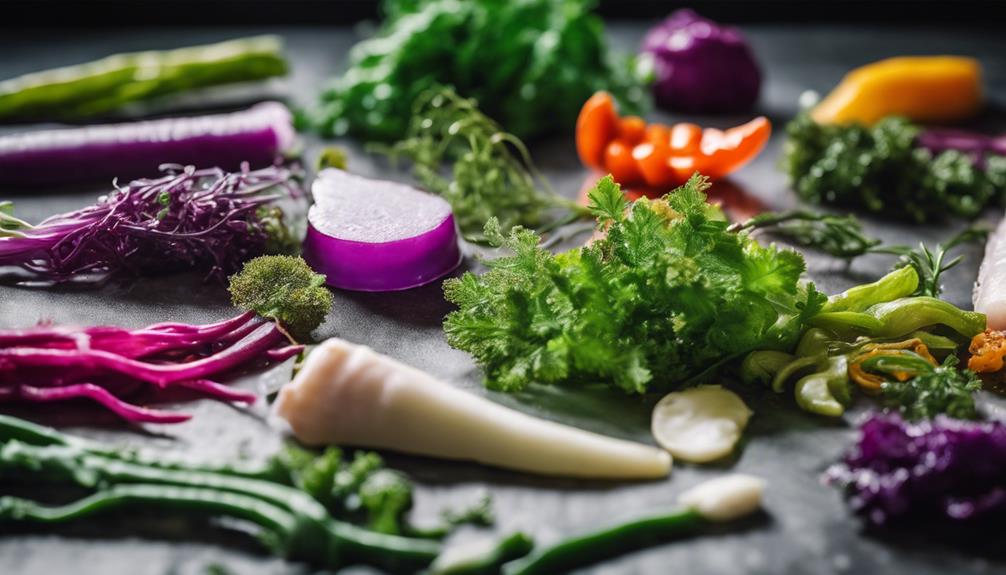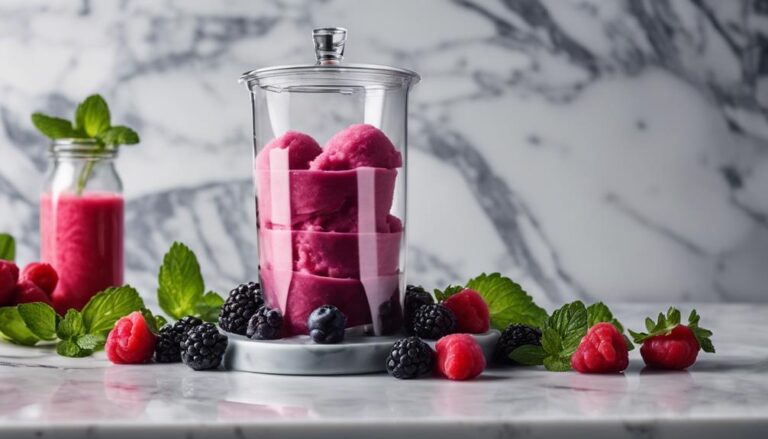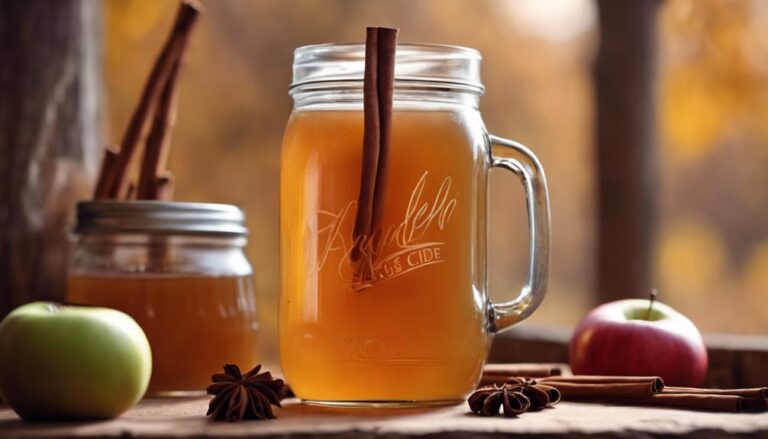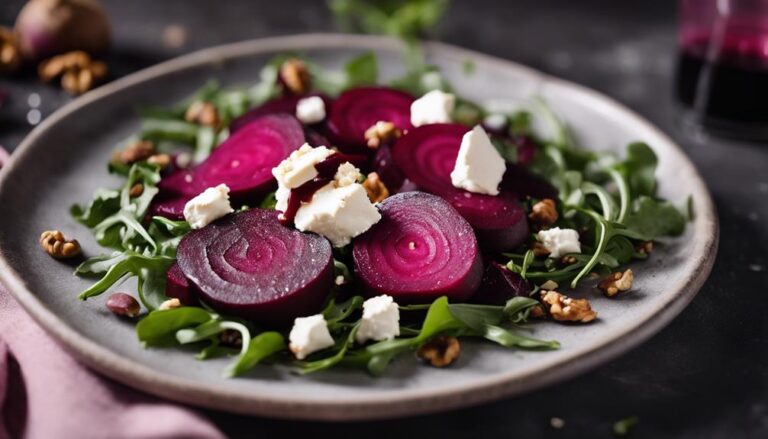Sous Vide Pickled Wild Vegetables
So, you want to explore your dishes with a wild twist? Enter the world of sous vide pickled wild vegetables! Imagine tender, flavorful veggies infused with tangy goodness. The magic happens with controlled temperatures, making every bite a burst of unique taste. Fermentation is the secret ingredient here, elevating flavors while extending shelf life. Plus, it's a cool way to preserve food with a cultural flair. Get ready to embark on a wild ride with sous vide pickled veggies that pack a punch of flavor and crunchiness. Engage and discover a whole new world of culinary creativity.
What You Will Learn Here
- Sous Vide Pickled Wild Vegetables combine precision cooking with tangy, crunchy preservation.
- Fermentation enhances flavor, extends shelf life, and preserves cultural culinary heritage.
- Temperature control in sous vide ensures consistent tenderness and safety for pickled wild vegetables.
- Pickling brine adds unique texture and tangy taste to wild vegetables, creating a flavorful profile.
- Sous Vide techniques maintain crunchiness and enhance the overall culinary experience of pickled wild vegetables.
Culinary Roots in Rural Areas
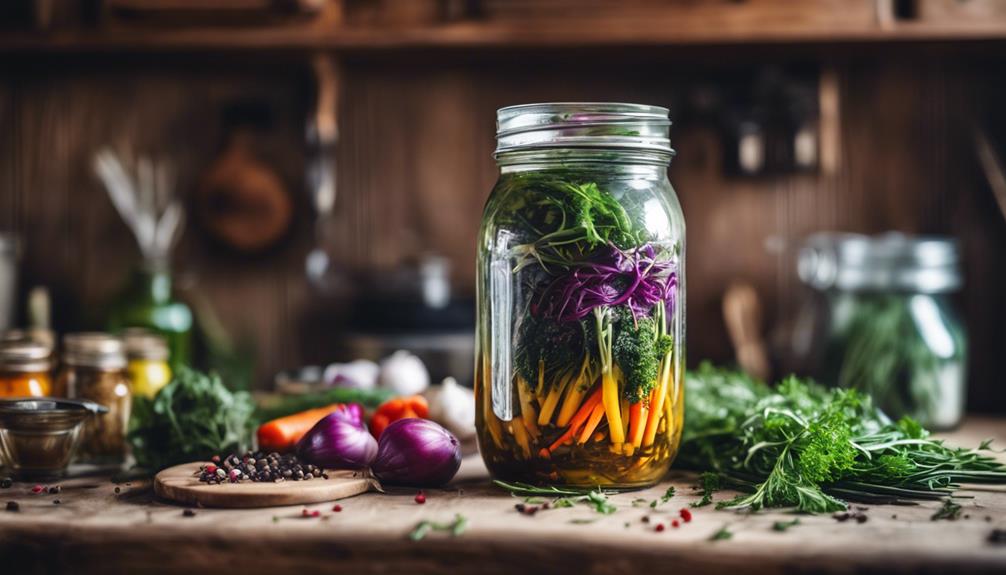
So, you're pondering the origins of your favorite dishes, huh? Let's chat about how rural areas are the unsung heroes of culinary traditions.
Picture this: each dish tells a story of the land it comes from, the people who lovingly prepare it, and the ingredients that dance together in perfect harmony.
It's like a delicious gossip session where the flavors spill the tea on community connections, local ingredients, and the impact of tradition on your plate.
Rural Culinary Traditions
Exploring the culinary roots in rural areas reveals a rich tapestry of traditional dishes passed down through generations. Rural traditions are like a treasure trove of delicious secrets waiting to be uncovered. Picture this: culinary innovation in the middle of nowhere, with recipes that have stood the test of time.
These traditions are the real deal, not some fancy food trend that disappears faster than you can say 'avocado toast.' From hearty stews simmered over open fires to pies bursting with fruits picked straight from the orchard, rural culinary traditions are all about good ol' fashioned comfort food.
Local Ingredients Impact
Imagine this: delving into the culinary roots of rural areas reveals how local ingredients profoundly influence traditional dishes passed down through generations.
When it comes to rural cooking, it's all about local sourcing and sustainability.
Imagine this scenario: your grandma's secret recipe for pickled wild vegetables wouldn't be the same without those freshly picked veggies from the nearby farm.
The magic lies in the seasonal flavors and the crisp freshness that only local ingredients can bring.
Picture the burst of tangy goodness in every bite, knowing that it's all thanks to the produce just a stone's throw away.
Community Food Connections
When you consider the culinary roots in rural areas, envision the intricate web of community food connections that breathe life into traditional dishes. In these tight-knit communities, culinary heritage and food sharing traditions aren't just about the taste but also about preserving a way of life.
Food preservation techniques like pickling and fermenting have been passed down through generations, ensuring that seasonal bounty lasts long after harvest time. Community gatherings centered around food are where stories are shared, recipes are exchanged, and laughter echoes through the fields.
These connections go beyond just sustenance; they're a celebration of togetherness and a reminder of the deep-rooted bonds that tie us to our past and each other.
Foraged Wild Vegetables
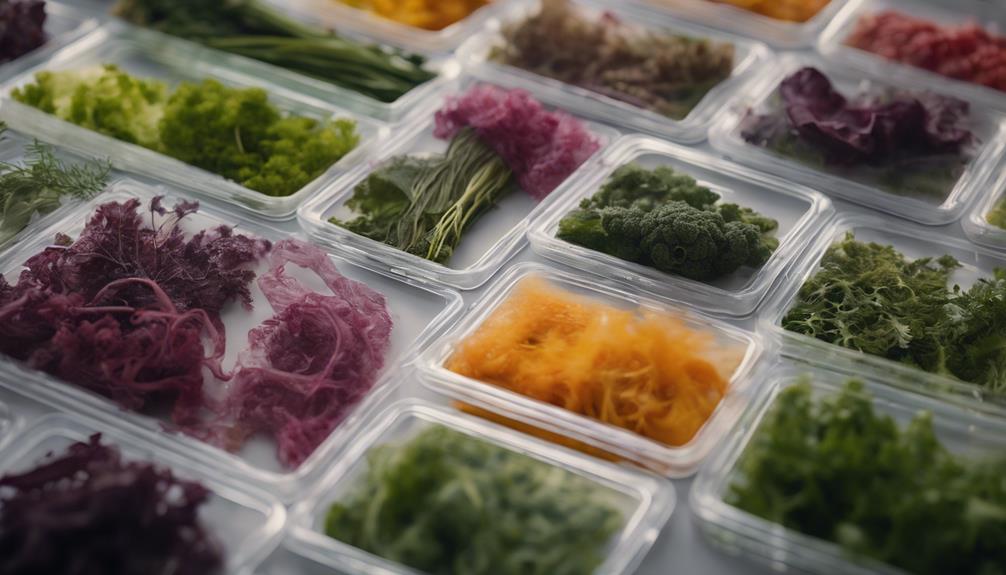
Foraging for wild vegetables can be an exciting and rewarding way to connect with nature and discover unique flavors. It's like a treasure hunt, but instead of gold, you find delicious greens! Here are some tips to make your foraging adventure a success:
- Flavor Profiles: Each wild vegetable has its own distinct taste, from peppery wild arugula to tangy wood sorrel.
- Sustainability Practices: Remember, only take what you need and leave enough for wildlife and future foragers.
- Health Benefits: Wild vegetables are often packed with nutrients and can add a healthy boost to your meals.
- Culinary Techniques: Experiment with different cooking methods like sautéing, roasting, or even pickling to enhance the flavors of your foraged finds.
- Identification: Always be 100% sure of what you're picking. Eating the wrong plant can turn your foraging trip into a not-so-fun adventure!
Wild Vegetable Creations
Hey there, ready to take your wild veggie game to the next level?
How about whipping up some Foraged Wild Nettle Soup, indulging in a creamy Wild Mushroom Risotto, or maybe trying out a fancy Sous Vide Wild Garlic Pesto?
These creations will have you feeling like a gourmet chef in no time – wild veggies never tasted so good!
Foraged Wild Nettle Soup
Exploring the woods for wild nettles can lead to a flavorful and nutritious soup creation. So, you're out there, part nature explorer, part culinary genius.
Here are some tips for your wild nettle soup adventure:
- Watch Your Fingers: Those nettles may look innocent, but they can sting like a grumpy bee. Wear gloves!
- Blanch Away: Boil those nettles for a minute to get rid of the sting before turning them into soup.
- Get Creative: Add potatoes, onions, and a dash of cream for a velvety finish.
- Seasonal Goodness: Embrace sustainable foraging and cook with the seasons.
- Garnish Like a Pro: Sprinkle some grated cheese or a drizzle of olive oil to elevate your soup game.
Get ready to impress your taste buds with this wild creation!
Wild Mushroom Risotto
Indulge in the rich and earthy flavors of a delectable wild mushroom risotto, a tantalizing dish that celebrates the bounty of nature's offerings. When cooking this creamy and comforting dish, remember these tips:
- Seasonal ingredients: Use fresh wild mushrooms like chanterelles or porcinis for an authentic taste that sings of the forest floor.
- Flavor profiles: Enhance the dish with a splash of white wine and a sprinkle of parmesan cheese for that perfect balance of savory goodness.
- Cooking techniques: Master the art of slowly adding warm broth to coax out the rice's creamy texture and deep flavors.
- Texture control: Keep stirring to release the risotto's natural creaminess while ensuring the rice is perfectly al dente.
- Enjoy: Remember to savor each spoonful, letting the flavors dance on your taste buds!
Sous Vide Wild Garlic Pesto
For an exquisite burst of wild flavors in your culinary creations, consider delving into the domain of Sous Vide Wild Garlic Pesto. If you're looking to jazz up your dishes with a touch of the untamed, wild garlic recipes in a sous vide style might just be the ticket. Here are some reasons why you should give it a shot:
- Intense Flavor Infusion: Sous vide techniques lock in the wild garlic's bold flavors, ensuring every bite is packed with deliciousness.
- Consistent Texture: Say goodbye to chunky pesto mishaps; sous vide helps achieve a smooth, velvety consistency every time.
- Minimal Effort: Let the sous vide machine do the work while you sit back and dream of all the tasty dishes you'll create.
- Versatile: Spread it on toast, swirl it into pasta, or even use it as a marinade – the possibilities are endless.
- Impress Your Friends: Serve up a dish with sous vide wild garlic pesto, and watch your pals be amazed at your culinary prowess.
Sous Vide Temperature Recommendations
Alright, so let's talk about sous vide temperature recommendations – the essential key to nailing your wild vegetable creations.
You want to hit those ideal cooking temperatures precisely to guarantee both deliciousness and safety.
Ideal Cooking Temperatures
To guarantee perfectly cooked and flavorful dishes, choosing the appropriate temperature for sous vide cooking is essential. When it comes to temperature accuracy in sous vide, precision is key.
For cooking techniques like pickling vegetables, maintaining a consistent temperature is vital. Vegetables need that perfect balance of heat to infuse the pickling flavors without losing their crunch. Imagine this: too hot, and your veggies turn to mush; too cold, and they remain bland. So, aim for that sweet spot where the magic happens!
Whether you're pickling wild vegetables or experimenting with other ingredients, nailing the ideal cooking temperature will elevate your sous vide game to new heights. Happy cooking!
Precision in Sous Vide
Maintaining precise temperatures in sous vide cooking guarantees ideal flavor infusion and texture retention in your dishes. Temperature control is the secret sauce in sous vide magic. It's like giving your food a spa day – consistent warmth that makes everything tender and flavorful.
When you lock in the perfect temperature, you're basically telling your ingredients, 'Hey, take your time, relax, and become delicious.' Sous vide cooking techniques are all about pampering your food. It's the gentle art of letting flavors mingle and textures become besties.
Ensuring Food Safety
Guarantee the safety of your sous vide dishes by following recommended temperature guidelines.
When it comes to food preservation techniques, maintaining the right temperature is key.
For safety precautions, always make certain that your food reaches the minimum recommended temperature and stays there for the required time to eliminate any harmful bacteria.
Remember, sous vide cooking is like a science experiment – you want to make sure you get the results you intended, which in this case is a delicious and safe meal.
Final Thoughts
Considering the overall flavor profile and crunchiness of the vegetables, your final thoughts on this sous vide pickled wild vegetables recipe will likely revolve around its unique texture and tangy taste. The impact of fermentation in pickling these wild vegetables not only enhances their flavor but also contributes to their extended shelf life. It's like time-traveling back to a time when preserving food was a cultural art form, ensuring that the essence of these wild vegetables lives on.
As you crunch into a perfectly pickled piece, you can't help but appreciate how this recipe isn't just about pickling but also about cultural preservation. The tangy kick from the pickling brine adds a zesty twist to the natural flavors of the wild vegetables, making each bite a delightful explosion of tastes.
Frequently Asked Questions
Can I Use Store-Bought Pickling Liquid for This Recipe?
You can use store-bought pickling liquid for convenience, but homemade offers more customization. Experiment with different pickling liquid alternatives to find the best flavor for your wild vegetables. Both options can work well in the recipe.
How Long Will the Pickled Wild Vegetables Last in the Fridge?
To guarantee freshness and flavor preservation, store your pickled wild vegetables in an airtight container in the fridge. With proper pickling process and storage tips, they can last up to three months, providing a delightful culinary addition.
Can I Reuse the Pickling Liquid for Another Batch?
Yes, you can reuse the pickling liquid for another batch. It offers benefits like infused flavors and time-saving, but there are risks of dilution or spoilage. Experiment with different wild vegetables for unique flavor profiles and exciting culinary opportunities.
Is It Necessary to Sterilize the Jars Before Pickling?
To guarantee jar cleanliness and uphold pickling efficiency, sterilize jars before pickling. This step is essential for food safety. The sanitized jars create an ideal environment for the pickling process, resulting in delicious, safe-to-eat pickled vegetables.
Can I Add Other Herbs and Spices to the Pickling Liquid?
Yes, you can add various herbs and spices to the pickling liquid to create unique flavor variations. Culinary experimentation allows you to combine different seasonings based on your taste preferences, enhancing the pickled vegetables.
Conclusion
So there you have it, folks! Pickling wild vegetables sous vide style is a fun and tasty way to get creative in the kitchen.
Remember to keep those temperature recommendations in mind to guarantee your veggies turn out just right.
Whether you're a seasoned chef or just starting out, give it a try and see what delicious creations you can come up with.
Happy pickling!
